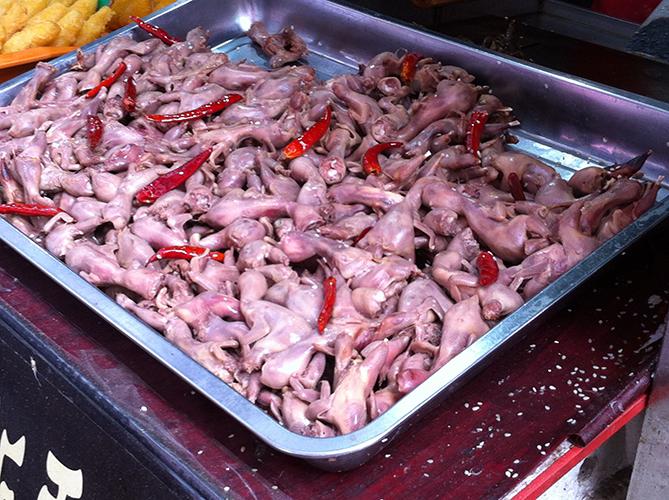10 of the Strangest Foods of the World
October 28, 2016
When we think of strange foods, many think of foreign foods like the foie gras, kangaroo, piranha, camel, shellfish or horse sausage. Though the following foods can be seen as unusual, there are even more uncanny dishes that are lesser known to us. Some are delicacies of foreign cultures while other are typical snacks, (10 being least strange and 1 as being most strange food within this list).
10. Surströmmin
Fermented canned fish from Sweden, apparently has one of the most revolting smells known, and it’s called Surströmmin. The fish itself is a fermented Baltic Sea ferring.
It is said to relieve an uneasy stomach and writer’s block. According to Geotraveler’s niche, blogger Lola Akinmade Åkerström, “It definitely does not taste like chicken. It doesn’t look like, taste like, or smell like anything you’ve ever tried before, and I probably won’t be suggesting a surströmming encore in the future.”
9. Haggis
When we think of pudding we think of sweet factory made gelatin crème either vanilla or chocolate flavor, americans don’t often carry savory puddings in our isles. Haggis, a savory pudding, includes unusual ingredients such as sheep’s heart, liver, lungs, mixed with onions, oatmeal, stock, suet, salt and all this contained by the stomach lining of sheep (much like a sausage). Unfortunately there are little to no health benefits of haggis, due to the fact that it is very high in salt and fat content. Buzz Bishop, food writer, describes haggis as, “Spicy oatmeal. That’s the best description I can come up with. The meats are not the main ingredient in haggis, the oats are what binds it together, and it is a heavily spiced dish, so the best I can say is haggis tastes like a spicy oatmeal.”
8. Fried Spider
Delicacy of Cambodia, fried spider or “a-ping” is a specialty snack enjoyed by both tourists and locals. Supposedly this custom of eating tarantulas/spider during the rule of the Khmer Rouge was an act of desperation when there was a food shortage during the 1800’s. Many believe that the tarantulas hold many health benefits including soothing backaches and soothing breathing problems in children. It is also said to have certain properties to help increase natural beauty, including the lengthening one’s hair.
According to travel writer for Timetravelturtle.com, Michael Turlte said,
“It tastes like digested insects – not like chicken, as the waiter had promised. It’s not disgusting but neither is it a particularly enjoyable sensation. The more I chew it, the more it turns into a hardened little ball. It’s the reverse of that caramel lolly I had imagined.”
7. Sannakji
Cut into small pieces and still alive, served with sesame oil and garnish, octopus, known as Sannakji, is a common delicacy throughout Korea and other parts of Asia. The dish is prepared by slicing baby octopus up into small pieces, served and eaten. The dish itself is dangerous as there have been several deaths occurring after attempting to swallow the still-active tentacles. Sannakji itself is a great source for iron, calcium, potassium, phosphorus, selenium, omega-3, vitamins and vitamins A, B and C. It is said that eating the fresh octopus helps fighting cancer, heart disease and depression. Writer for the website Quora, Colin Chau says “When I had it for the first time, it was novel for about the first five seconds, and then it was just sashimi to me, just prepared in a different way.”
6. Mopane worms
Mopane worms are both a delicacy and a staple for the people of Zimbabwe. The insect is commonly known as the emperor moth and scientifically known as the Gonimbrasia Belina, which is native to parts of the southern hemisphere of Africa. It’s a great source of protein. The mopane worms can be dried or cooked into a tomato sauce.
According to the African Travel Expert Anouk Zijlma “The initial taste of the Mopane worm wasn’t so bad, hidden by the garlic and onions. But as I continued to chew, the real flavor became unmasked and I detected a blend of earth, salt and drywall. It wasn’t very good.”wr
5. Escamoles
Escamoles, native to central Mexico and once a delicacy of the Aztecs, is also known as insect caviar. Escamoles are the pupae and ant larvae that are harvested from the Agave tequilana or Agave americana. The dish itself can cost up to 1000 pesos or $76. Though it’s rich in protein, Escamole is also rich in vitamins A and E, and natural salts. It’s also believed to give you strong eyesight.
Alwausfoodie.com wrote,
“When it comes to taste, Escamole is slightly nutty and buttery. The eggs are about the size of beans. With a consistency that matches that of nutty cottage cheese, it is often eaten in a taco with guacamole with a liberal sprinkling of madness! Some people who have eaten it claim that it tastes like a mixture of bacon along with peanut butter. Some others claim that it tastes like corn… On the whole, the response towards the taste is indeed positive.”
4. Balut
Originating from the Philippines, a common street food served with beer and eaten with salt, chili, garlic and vinegar, balut is a fertilized duck egg that has been incubated for 14 to 21 day that is later boiled or steamed. The point of the dish is to eat the whole egg with the almost developed embryo inside. The belief is that balut can help with sexual stamina (in men), stimulator for sexual drive, hangover cure, and increases the chances of a healthy pregnancy. Balut itself has high levels of calcium, iron, and protein. The process of eating the balut is first drinking the fluid of the egg and then proceeding to eating the creamy and crunchy remains of the underdeveloped duck embryo .
Travel writer Huai Bin remarks “Well it just tastes like a regular boiled egg, except balut has a rich duck broth and a crunchy texture where the half formed chick resides…I highly recommend that you try balut if you’re ever in the Philippines – it’s delicious in its own way and it’s one of those things that you have to try when you’re there.”
3. Kopi Luwak
Originated from Indonesia, now also produced in Vietnam and the Philippines, the Kopi Luwak, or one of the most expensive coffees in the world, is not your typical coffee. The coffee bean itself is harvested from the feces of the palm civet, an indigenous animal of Southeast Asia. The name Kopi Luwak directly translates as Coffee Asian Palm Civet. During the Dutch occupation of Indonesia in the 1800’s, the dutch coffee plantation owners didn’t allow the farmers to harvest any coffee for their own use. Eventually the farmers deep desire for coffee allowed them to think up an alternative to get their caffeine fix, they decided to harvest the excreted remains of the coffee bean from the civet. The beans themselves are thoroughly washed, dried, skinned and later hand-sorted to remove bad beans. After roasting the beans themselves loose a significant amount of their original weight, for example 22 pounds of beans will become 4.4 pounds after being roasted, while regular coffee beans will only lose only 15 to 20 percent.
According to coffee aficionado Tim Hayward, a British columnist and broadcaster,
”The coffee brews faster than my regular blend on the same grind and produces a less oily shot with a pink tint to the crema. On first taste it’s pretty fantastic with all of the higher notes you tend to get with a well-roasted bespoke coffee (regular civilian drinkers, myself included, seem to see coffee in terms of big, bassy low-end flavours and smells. Coffee people seem to seek the distinctions in the lighter, more evanescent notes) but the defining characteristic is a lovely, long, subtly nutty aftertaste.”
2. Birds Nest
One of the most expensive dishes in the world, the bird’s nest soup, is considered a delicacy among east asian countries, particularly China. It is perceived that the soup contains medical benefits like aiding in digestion, strengthening the immune system and increasing libido.
The birds nest soup is made by harvesting the nest from the swiftlet; indigenous to Southeast Asia the bird typically lives in caves. The nest itself is made from the saliva of the bird and takes approximately 35 days for the bird to build.
The nest is harvested, cleaned with cold water, dried and stored in a cool place. When preparing the dish, the nest is soaked in icy water before being boiled in chicken broth and cornstarch. Sometimes it is also turned into a sweet gelatinous dessert.
Erik Trinidad, a prominent food and travel writer for cookingchaneltv.com, gives the soup a two out of five stars, “It wasn’t the best soup I’ve ever had, but it wasn’t disgusting. It feels and tastes like a basic chicken soup with minimal ingredients that you could easily make yourself — unless you’re keen on buying into the medicinal properties of bird nests.”
1. Testicles
Rocky Mountain Oysters is a dish that consists of deep frying bull testicles. Though the thought of eating any form of gonad may seem repulsive to the majority of people, testicles are a common dish in many countries. In the U.S. they are a typical dish of the Midwest, deep fried bull testicles served as hors d’oevre, in Afghanistan bull testicles are served as a kebab, in Greece, Cyprus, Italy, Iran and Turkey they serve lamb testicles, roasted over coals and served with a heavy gravy. Though there is no definite benefit to eating this, it is rumored that eating the testicles of any animal is to aid sexual performance in men.
Writer for Modern Farmer magazine, Anna O’Brien said, “Rocky Mountain oysters are mostly like scallops in consistency, without the briny taste, and not any more off-putting than, say, a corndog. With all the offal-eating going on, perhaps it’s time for the Rocky Mountain Oyster to step out of the realm of oddity.”














